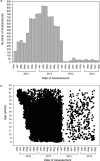The Philadelphia Neurodevelopmental Cohort: constructing a deep phenotyping collaborative
- PMID: 25858255
- PMCID: PMC4598260
- DOI: 10.1111/jcpp.12416
The Philadelphia Neurodevelopmental Cohort: constructing a deep phenotyping collaborative
Abstract
Background: An integrative multidisciplinary approach is required to elucidate the multiple factors that shape neurodevelopmental trajectories of mental disorders. The Philadelphia Neurodevelopmental Cohort (PNC), funded by the National Institute of Mental Health Grand Opportunity (GO) mechanism of the American Recovery and Reinvestment Act, was designed to characterize clinical and neurobehavioral phenotypes of genotyped youths. Data generated, which are recently available through the NIMH Database of Genotypes and Phenotypes (dbGaP), have garnered considerable interest. We provide an overview of PNC recruitment and clinical assessment methods to allow informed use and interpretation of the PNC resource by the scientific community. We also evaluate the structure of the assessment tools and their criterion validity.
Methods: Participants were recruited from a large pool of youths (n = 13,958) previously identified and genotyped at The Children's Hospital of Philadelphia. A comprehensive computerized tool for structured evaluation of psychopathology domains (GOASSESS) was constructed. We administered GOASSESS to all participants and used factor analysis to evaluate its structure.
Results: A total of 9,498 youths (aged 8-21; mean age = 14.2; European American = 55.8%; African American = 32.9%; Other = 11.4%) were enrolled. Factor analysis revealed a strong general psychopathology factor, and specific 'anxious-misery', 'fear', and 'behavior' factors. The 'behavior' factor had a small negative correlation (-0.21) with overall accuracy of neurocognitive performance, particularly in tests of executive and complex reasoning. Being female had a high association with the 'anxious-misery' and low association with the 'behavior' factors. The psychosis spectrum was also best characterized by a general factor and three specific factors: ideas about 'special abilities/persecution,' 'unusual thoughts/perceptions', and 'negative/disorganized' symptoms.
Conclusions: The PNC assessment mechanism yielded psychopathology data with strong factorial validity in a large diverse community cohort of genotyped youths. Factor scores should be useful for dimensional integration with other modalities (neuroimaging, genomics). Thus, PNC public domain resources can advance understanding of complex inter-relationships among genes, cognition, brain, and behavior involved in neurodevelopment of common mental disorders.
Keywords: Community cohort; adolescents; anxiety; behavior; children; comorbidity; genomics; mood; neurocognition; neuroimaging; psychopathology; psychosis; public domain; structure; young adults.
© 2015 Association for Child and Adolescent Mental Health.
Figures



References
-
- Beesdo-Baum K, Hofler M, Gloster AT, Klotsche J, Lieb R, Beauducel A, Buhner M, Kessler RC, Wittchen HU. The structure of common mental disorders: a replication study in a community sample of adolescents and young adults. [Research Support, Non-U.S. Gov't]. International Journal of Methods in Psychiatric Research. 2009;18(4):204–220. - PMC - PubMed
-
- Binbay T, Drukker M, Elbi H, Tanik FA, Ozkinay F, Onay H, Zagli N, van Os J, Alptekin K. Testing the psychosis continuum: differential impact of genetic and nongenetic risk factors and comorbid psychopathology across the entire spectrum of psychosis. [Research Support, Non-U.S. Gov't]. Schizophrenia Bulletin. 2012;38(5):992–1002. - PMC - PubMed
-
- Calkins ME, Moore TM, Merikangas KR, Burstein M, Satterthwaite T, Bilker WB, Ruparel K, Chiavacci R, Wolf D, Mentch FD, Qiu H, Connolly J, Sleiman PM, Hakonarson H, Gur RC, Gur RE. The psychosis spectrum in a young community sample: Findings from the Philadelphia Neurodevelopmental Cohort. World Psychiatry. 2014;13:296–305. - PMC - PubMed
-
- dbGaP [February 6, 2015];Neurodevelopmental Genomics: Trajectories of Complex Phenotypes. 2014 from http://www.ncbi.nlm.nih.gov/projects/gap/cgibin/study.cgi?study_id=phs00....
Publication types
MeSH terms
Grants and funding
LinkOut - more resources
Full Text Sources
Other Literature Sources
Molecular Biology Databases

